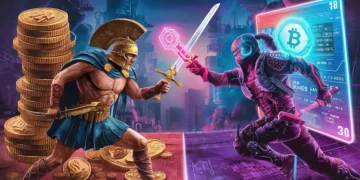The blockchain technology forms the base for non-fungible tokens (NFTs) and protects from counterfeiting or tampering through encryption protocols. Blockchain ensures transparency, authenticity, immutability, and much more by recording transactions and ownership changes on the network and assigning unique identifiers or tokens to every NFT. Moreover, blockchain’s decentralized and autonomous nature has reduced the potential risk of manipulation and fraud in the NFT market, further enhancing transparency and trust.
In this article, we will redefine the strengths of blockchain and how Blockchain technology empowers the NFT domain.
The Basics of NFTs
NFT, short for non-fungible tokens, refers to digital tokens that cannot be replaced. Hence, they are unique. By contrast, cryptocurrencies and other physical forms of money are fungible. This means the currencies can be used to exchange or trade for another. NFTs contain a virtual signature that makes each token unique. They are essentially digital assets ranging from photos, audio files, videos, and other digital formats. NFTs can include comic books, artwork, trading cards, sports collectibles, games, and more.
One needs to understand how they work on blockchain networks to understand how cryptographic assets work. NFTs are cryptographic assets whose transactions are recorded on the distributed public ledger. Every NFT has a unique identification code that distinguishes it from other tokens. This information makes transferring NFTs between owners and verifying their ownership easier. Each NFT holds a value the digital market sets based on supply and demand. They are bought and sold like digital or physical assets are traded. They represent real-world items, including real estate and artwork, and make tokenization of these tangible assets more secure and efficient, reducing the possibilities of fraud.
The Role of Blockchain Technology in NFTs
- Transparency and Authenticity
Blockchain technology ensures NFTs’ transparency, provenance, and authenticity by recording transactions and ownership changes on the blockchain network and assigning unique identifiers or tokens to every NFT. By leveraging the distributed ledger and decentralized nature of blockchain, these non-fungible tokens can be traced back to the original creators. This ensures transparency and authenticity.
The underlying technology of non-fungible tokens is blockchain, which maintains an unchangeable transaction ledger. Every NFT transfer, ownership change, or creation is recorded digitally as blocks on the chain. These transactions are immutable because they cannot be altered once recorded. This provides a tamperproof and permanent record of ownership history.
Within the blockchain world, another technology that governs NFT transactions is known as smart contracts. They are self-executing contracts with pre-set conditions. Smart contracts can execute the terms of the agreement automatically when the pre-determined conditions are fulfilled. This ensures that every NFT transfer or sale terms are met without third-party intervention.
Non-fungible tokens have received the spheres of entertainment and art, transforming how users value, consume, and create digital content. With NFTs, it is not only about buying or selling tokens but empowering creators, revolutionizing the relationship between them and their audiences, and reshaping value perceptions in the digital sphere. Through democratizing, creativity, revenue streams, ownership, authentication, and enhanced fun engagement, NFTs have gone beyond art to reshape different industries.
- Collectibles and Memorabilia
Blockchain has opened the doors to new possibilities for collectibles and memorabilia, ensuring more accessibility, verifiability, and security for users. As the blockchain industry continues to evolve, the need for professional developers also increases. Creating collectibles and memorabilia allows creators to tokenize their work and offer compelling solutions for the virtual world. Also, there are many best crypto sportsbooks that offer NFTs to revive the world of virtual collectibles and allow fans to own unique items such as trading cards, snippets from sports events, or even virtual sneakers.
Conclusion
To conclude, as we explore emerging blockchain technologies for NFTs, it is essential to consider the efficiency and scalability that blockchain platforms bring to the digital world that determines their contribution to NFTs. Blockchain has enabled seamless integration of NFTs, allowing users to lend, trade, and collateralize NFTs for financial gain. The adoption of blockchain, cryptocurrencies, smart contracts, and NFTs has increased, thereby leading to more integration of NFTs at an exponential rate, reshaping the future of the digital industry. Beyond this cutting-edge technology, NFT’s commitment to developing decentralized platforms through blockchain is undeniable.





















































































order cheap clomiphene tablets order cheap clomid tablets buy clomid price can i buy clomiphene without dr prescription where can i get clomid pill can i buy clomiphene no prescription cost of generic clomid pills
Thanks an eye to sharing. It’s top quality.
I couldn’t weather commenting. Warmly written!
buy cheap generic azithromycin – buy azithromycin 250mg pills flagyl order
buy generic semaglutide – where to buy semaglutide without a prescription cyproheptadine 4mg without prescription
purchase domperidone for sale – order motilium 10mg online cheap oral flexeril 15mg
where can i buy inderal – brand methotrexate 5mg buy methotrexate 10mg without prescription
purchase amoxil for sale – cheap amoxil sale generic ipratropium 100mcg
how to get zithromax without a prescription – azithromycin for sale nebivolol 20mg us
buy cheap generic augmentin – https://atbioinfo.com/ buy acillin pills for sale
order esomeprazole 40mg capsules – https://anexamate.com/ buy nexium sale
buy coumadin pills for sale – blood thinner buy losartan tablets
purchase meloxicam without prescription – https://moboxsin.com/ meloxicam 15mg generic
cheap deltasone 10mg – allergic reactions buy prednisone 40mg for sale
buy ed pills uk – buy ed medications online otc ed pills that work
amoxil tablet – cheap amoxicillin pill purchase amoxil online cheap
forcan brand – this order fluconazole 200mg without prescription
purchase cenforce online – on this site order cenforce 100mg online
tadalafil best price 20 mg – on this site cialis for daily use cost
purchase zantac for sale – ranitidine for sale ranitidine uk
does cialis lowers blood pressure – on this site cialis for bph insurance coverage
cheap viagra canada online – how to order viagra from canada 50mg viagra prices
I couldn’t resist commenting. Warmly written! sitio web
I’ll certainly bring back to be familiar with more. https://buyfastonl.com/gabapentin.html
This is a keynote which is in to my verve… Diverse thanks! Exactly where can I lay one’s hands on the phone details an eye to questions? https://ursxdol.com/cenforce-100-200-mg-ed/
This is the kind of scribble literary works I positively appreciate. https://prohnrg.com/product/priligy-dapoxetine-pills/
I’ll certainly bring back to be familiar with more. sibelium en ligne
More posts like this would persuade the online play more useful.
https://doxycyclinege.com/pro/ranitidine/
More articles like this would make the blogosphere richer. http://www.google.pt/url?q=https://www.instapaper.com/p/adip
This is the type of advise I turn up helpful. http://furiouslyeclectic.com/forum/member.php?action=profile&uid=24580
how to get dapagliflozin without a prescription – https://janozin.com/ order dapagliflozin online cheap
xenical price – on this site order orlistat